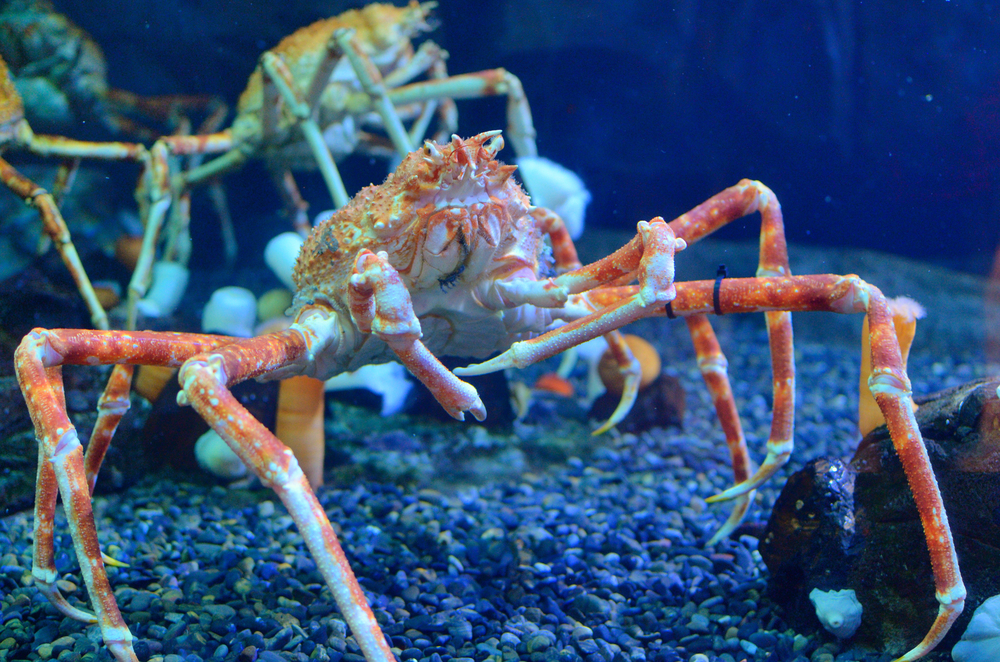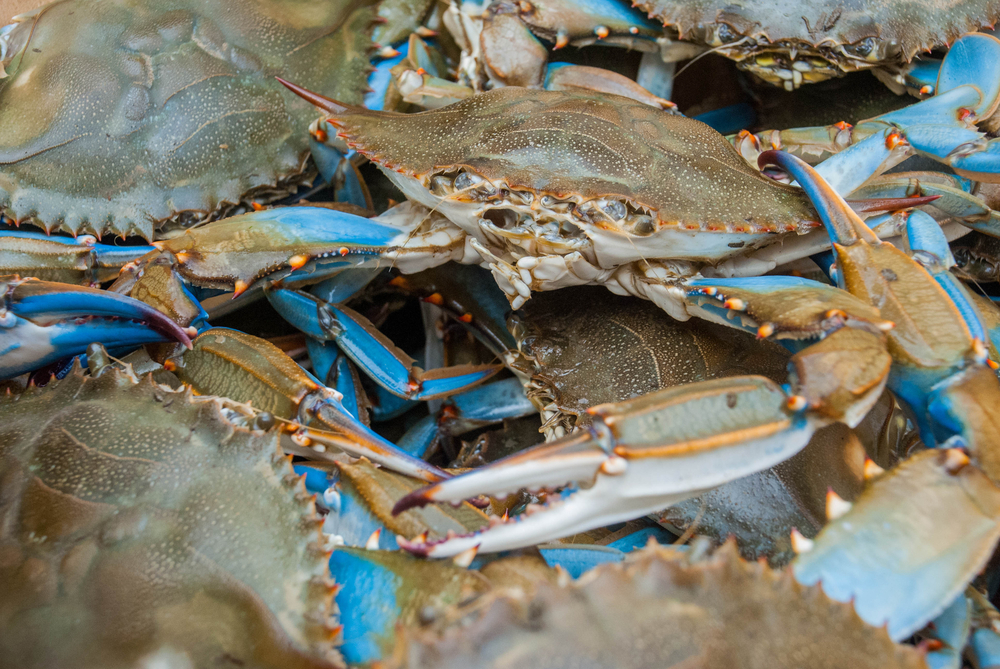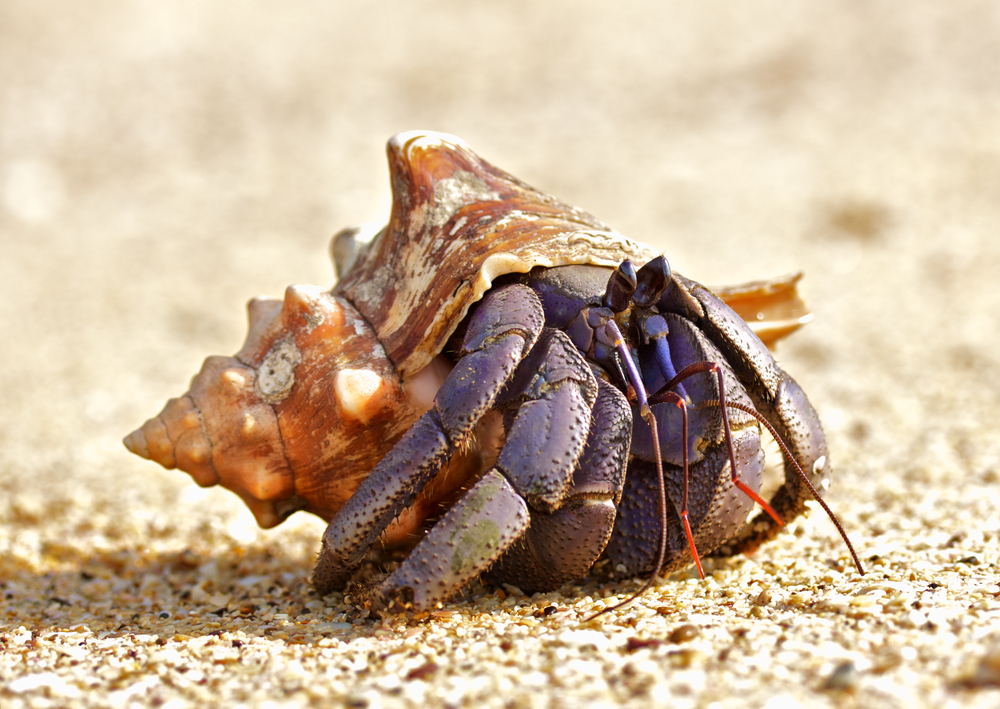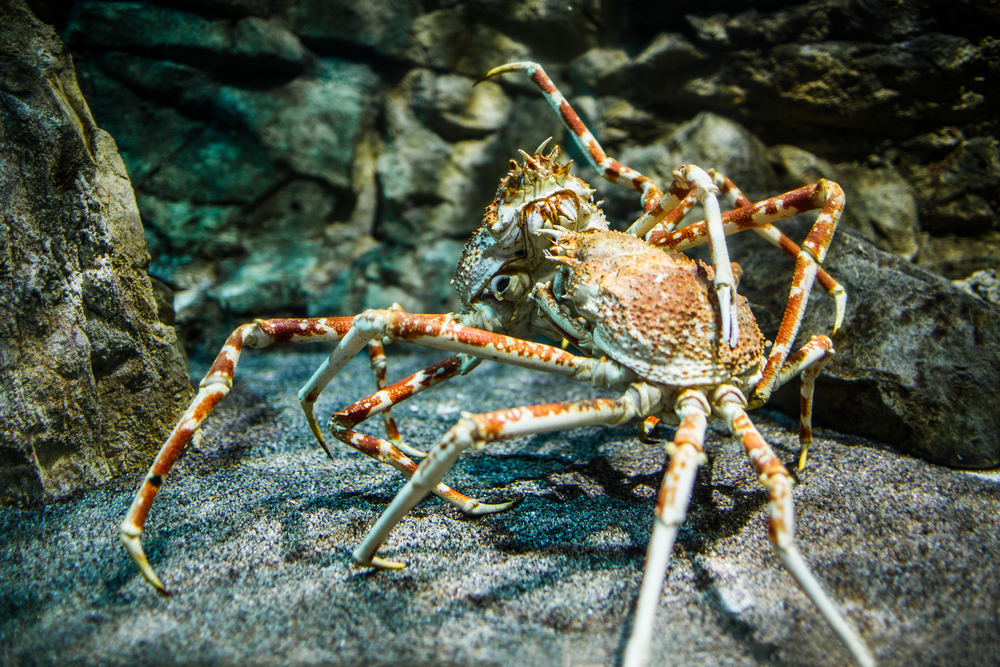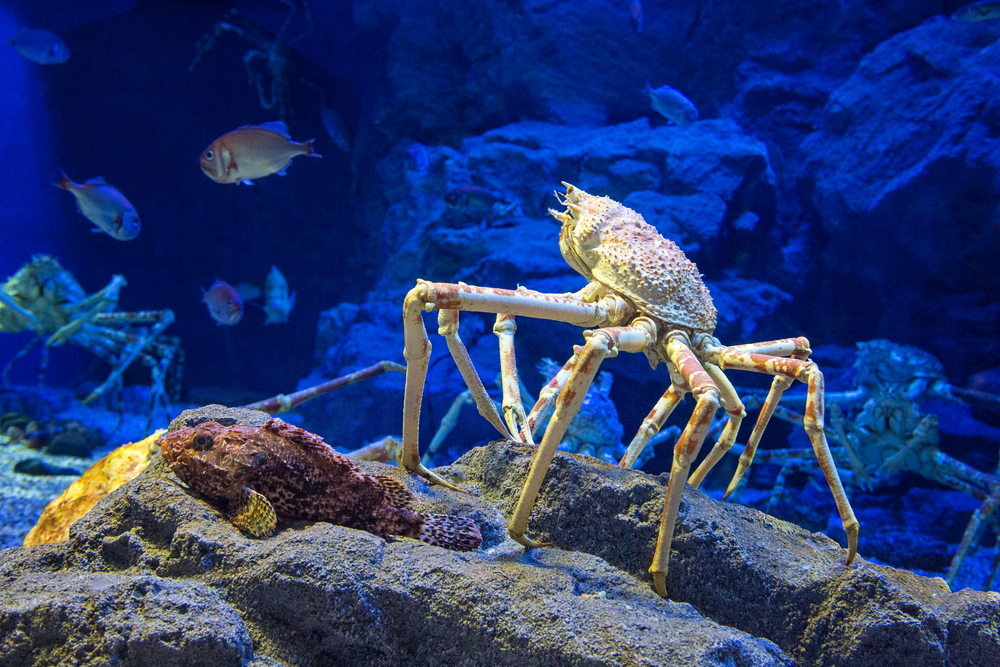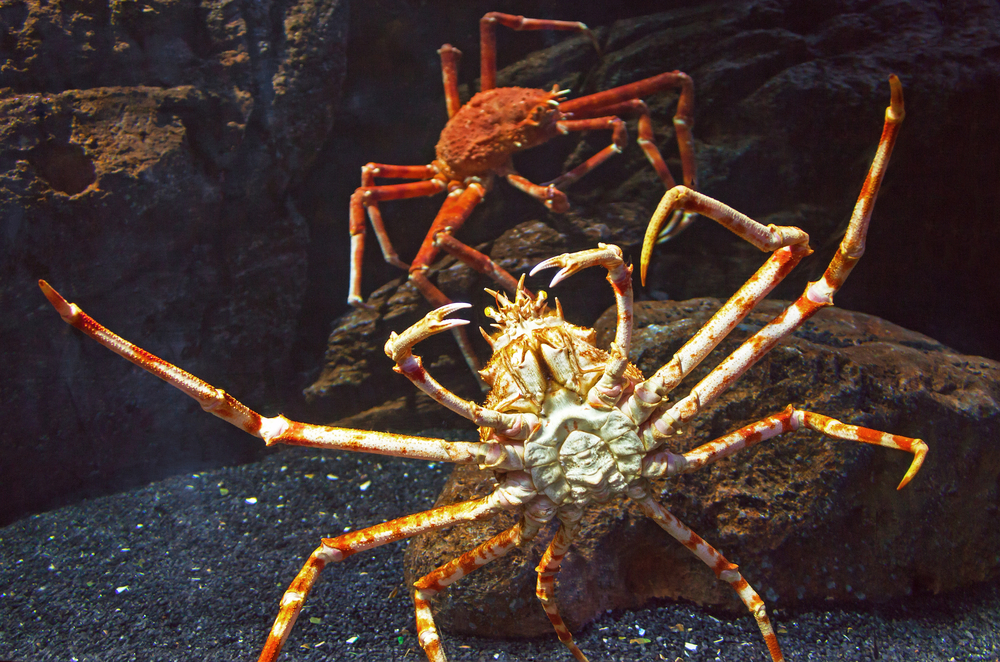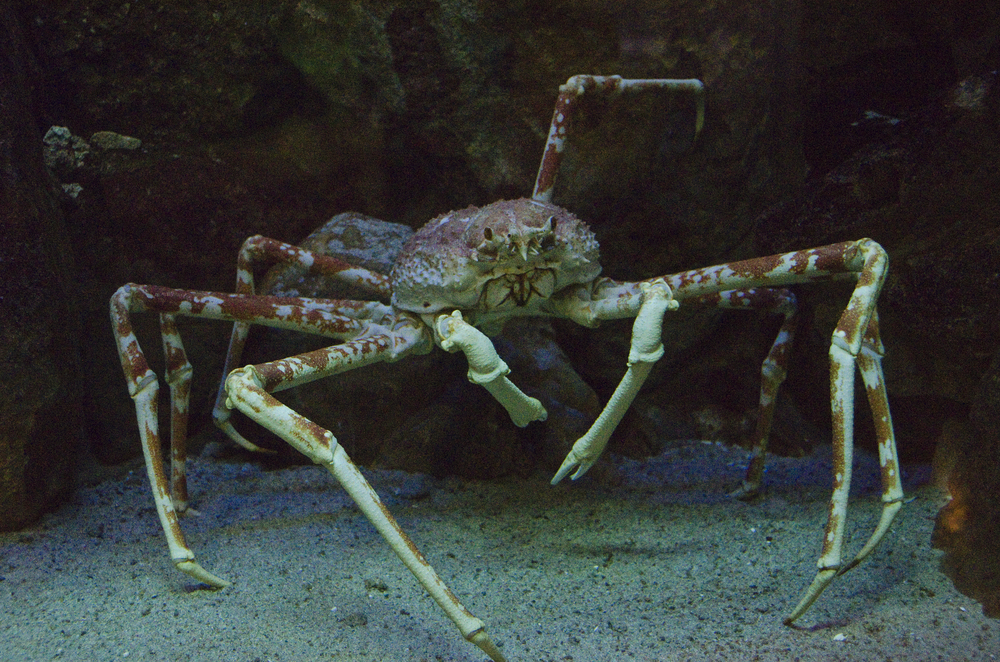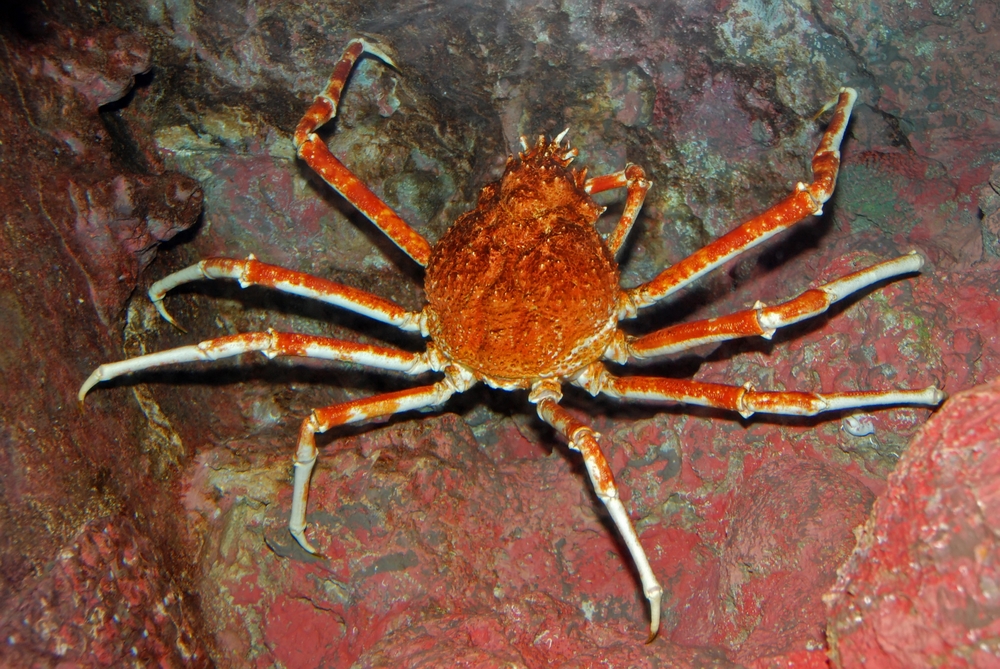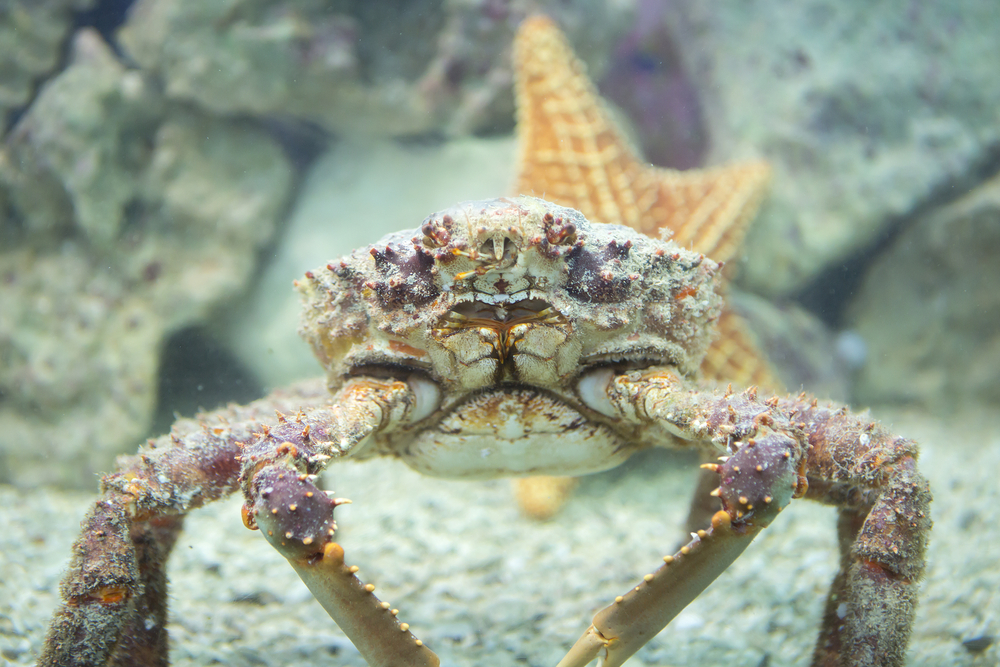About
The Spider Crab, known scientifically as the Maja squinado, is a marine crustacean belonging to the Animal Kingdom’s phylum Arthropoda and class Malacostraca. It is a member of the Majidae family, which comprises various species of spider crabs found worldwide. Spider crabs inhabit deep-sea waters, rocky reefs, and continental shelves across the Atlantic Ocean and the Mediterranean Sea.
These fascinating creatures are aptly named for their long, spindly legs that give them a spider-like appearance. They have a rounded, triangular carapace, typically covered in spines and small projections, providing them with effective camouflage among rocks and seaweed. Spider crabs exhibit sexual dimorphism, with males generally smaller than females and possessing a narrower abdomen.
Spider crabs are omnivorous scavengers, feeding on a variety of prey, including algae, mollusks, small fish, and carrion. They play a vital role in marine ecosystems by scavenging decaying matter and helping to maintain the balance of underwater ecosystems.
Conservation Concerns:
While specific data on the conservation status of spider crab populations are limited, they face several threats common to many marine species. Overfishing, habitat destruction, and pollution are significant concerns for spider crabs, particularly in areas where they are targeted by commercial fisheries or affected by habitat degradation.
Although spider crabs are not currently assessed on the IUCN Red List individually, the health of their habitats and overall marine biodiversity are crucial for their conservation. Efforts to reduce overfishing, protect critical habitats, and mitigate pollution in marine environments are essential for safeguarding spider crabs and other marine species.
Physical Characteristics
Spider crabs, belonging to the family Majidae, are a diverse group of marine crabs known for their long, spindly legs and camouflaging abilities. Among the various species of spider crabs, the Japanese spider crab (Macrocheira kaempferi) stands out as the largest, exhibiting some of the most extreme physical characteristics of the group. Here’s a detailed overview of the physical characteristics commonly associated with spider crabs, with specific mentions of the Japanese spider crab where applicable:
Size
- Leg Span: Spider crabs have wide leg spans relative to their body size. The Japanese spider crab, for example, can have a leg span of up to 12 feet (3.7 meters), making it the crab with the largest leg span in the world.
- Body (Carapace) Length: The carapace of spider crabs can vary widely among species. For the Japanese spider crab, the carapace can measure up to 16 inches (40 centimeters) in width.
- Weight: Weights vary significantly among the different species of spider crabs. The Japanese spider crab can weigh up to 42 pounds (19 kilograms).
Physical Characteristics
- Body Shape: Spider crabs have a rounded or triangular carapace with a rough texture, often covered in various sediments and organisms like algae and barnacles, which help in camouflage.
- Legs: They are most noted for their long, thin legs in comparison to their bodies. The legs are often many times longer than the body, aiding in their cryptic appearance and blending in with their surroundings.
- Claws: Spider crabs have claws (chelae) that vary in size and are used for feeding and defense. The claws can be quite powerful, especially in larger species.
- Coloration: The color of spider crabs tends to blend with their natural habitat. For instance, the Japanese spider crab has an orange body with white spots, which helps it camouflage against the ocean floor.
- Exoskeleton: The exoskeleton of spider crabs is hard and protective, providing defense against predators. Over time, the exoskeleton can become covered with various marine organisms, enhancing its camouflage.
- Eyes: Like other crabs, spider crabs have stalked eyes that allow them to look out for predators and prey. The eyes are usually small and can retract into grooves in the carapace.
Behavior and Adaptations
- Habitat: Spider crabs inhabit a variety of marine environments, from shallow tidal pools to depths of several hundred meters. The Japanese spider crab, for example, prefers the depths of 160 to 600 meters (525 to 1,970 feet) on the ocean floor.
- Camouflage: One of their most remarkable adaptations is their ability to camouflage. Many spider crabs attach sediments, algae, and other organisms to their shells to blend into their environment, providing protection from predators.
- Diet: They are omnivorous scavengers, feeding on a variety of dead animals, plant material, and occasionally hunting small fish or invertebrates.
Spider crabs’ unique appearance, characterized by their long legs and camouflaging abilities, alongside their fascinating behaviors, make them intriguing subjects of marine biology and popular attractions in aquariums worldwide
Reproduction
The reproductive cycle of spider crabs, characterized by their large size and distinctive appearance, consists of several key stages:
Mating Season: Spider crabs typically mate during the warmer months, although the exact timing can vary depending on the species and geographic location. Mating behavior often coincides with the migration of crabs to shallow waters or spawning grounds.
Courtship and Mating: During the mating season, male spider crabs exhibit various courtship behaviors to attract females. These behaviors may include visual displays, pheromone release, and physical interactions. Once a female is receptive, mating occurs, typically with the male grasping the female’s abdomen with specialized appendages called claspers.
Egg Brooding: After mating, female spider crabs carry fertilized eggs on their abdomen until they hatch. The eggs are often attached to specialized structures, known as pleopods or swimmerets, which provide protection and oxygenation. The brooding period can last several weeks to several months, depending on the species.
Release of Larvae: When the eggs are ready to hatch, the female spider crab releases larvae into the water. The larvae undergo a series of developmental stages, known as molts, as they drift with ocean currents. During this planktonic phase, the larvae feed on microscopic organisms and grow in size.
Settlement and Juvenile Stage: As the larvae mature, they undergo metamorphosis and settle on the seabed or other suitable substrates. Here, they transition into the juvenile stage, adopting the characteristic body shape of adult spider crabs. Juvenile crabs continue to grow and molt as they develop into adults.
Maturation and Reproduction: As juvenile spider crabs mature, they reach sexual maturity and become capable of reproducing. The timing of sexual maturity varies depending on factors such as diet, environmental conditions, and population density. Once mature, adult spider crabs participate in the reproductive cycle, mating, and producing offspring to continue the life cycle.
Understanding the reproductive cycle of spider crabs is crucial for their conservation and management, as it provides insights into population dynamics, reproductive success, and the factors influencing their survival in marine ecosystems. Conservation efforts aimed at protecting spawning grounds, minimizing habitat destruction, and reducing overfishing can help ensure the long-term sustainability of spider crab populations.
Lifespan
Spider crabs are a diverse group of crustaceans belonging to the family Majidae. They are characterized by their long, spindly legs and triangular bodies, resembling the appearance of spiders, hence their name. Spider crabs inhabit oceans worldwide, ranging from shallow coastal waters to deeper offshore regions. These crabs play vital roles in marine ecosystems as scavengers and prey for various predators. Here’s an overview of their lifespan and the threats they face:
Lifespan in the Wild: The lifespan of spider crabs in the wild can vary depending on species and environmental factors. Generally, spider crabs have relatively long lifespans compared to many other crustaceans, with some species living up to 10 to 15 years or more. However, specific data on the lifespan of individual species may vary, and some may have shorter lifespans due to predation, environmental conditions, and other factors.
Lifespan in Captivity: Information on the lifespan of spider crabs in captivity is limited, as they are primarily marine species and may not adapt well to captive environments. In aquarium settings, spider crabs may not reach their full lifespan due to challenges associated with replicating their natural habitat, providing adequate nutrition, and managing potential stressors.
Threats to the Spider Crab:
- Overfishing: Spider crabs are targeted by commercial fisheries for their meat, especially in regions where they are considered a delicacy. Overfishing can deplete spider crab populations, leading to declines in their numbers and disrupting marine ecosystems’ balance.
- Habitat Destruction: Coastal development, pollution, and habitat degradation threaten the habitats of spider crabs. Destruction of mangroves, coral reefs, and other critical marine habitats reduces the availability of shelter and food for spider crabs, impacting their survival and reproductive success.
- Climate Change: Rising ocean temperatures, ocean acidification, and changes in ocean currents associated with climate change can affect spider crab populations. These environmental changes may alter their distribution, disrupt their breeding cycles, and impact the availability of food resources.
- Bycatch: Spider crabs are often caught incidentally as bycatch in fishing gear targeting other species. Bycatch mortality can be significant, particularly if spider crabs are not the target of the fishing operation. Introducing measures to reduce bycatch, such as using escape panels in fishing nets, can help mitigate this threat.
- Pollution: Pollution from agricultural runoff, industrial discharge, and marine debris can negatively impact spider crab populations. Chemical pollutants can accumulate in their tissues, affecting their health and reproductive capabilities. Plastic pollution, in particular, poses risks as spider crabs may ingest or become entangled in plastic debris.
Conservation efforts aimed at sustainable fisheries management, habitat protection, pollution reduction, and climate change mitigation are crucial for ensuring the long-term survival of spider crab populations and the health of marine ecosystems they inhabit. Monitoring population trends, implementing regulations to prevent overfishing, and promoting sustainable fishing practices are essential steps in safeguarding these fascinating crustaceans.
Eating Habits
Spider crabs are marine crustaceans known for their long, spindly legs and large, often spiky exoskeletons. They are primarily scavengers and opportunistic feeders, playing an important role in marine ecosystems as both predators and prey.
Diet: Spider crabs have a diverse diet that includes a variety of marine organisms. They are primarily scavengers, feeding on dead or decaying organic matter such as fish carcasses, mollusk shells, algae, and other detritus found on the ocean floor. However, they may also opportunistically prey on small animals such as mollusks, crustaceans, and other invertebrates.
Feeding Behavior: Spider crabs use their powerful claws to manipulate and break apart food items. They are well-adapted for scavenging, with specialized mouthparts and feeding appendages that allow them to extract nutrients from a wide range of food sources. Their long, spindly legs are also used to probe and explore the ocean floor in search of food.
Foraging Strategy: Spider crabs are bottom-dwelling creatures and are commonly found in rocky or sandy habitats along the ocean floor. They are nocturnally active, often venturing out under the cover of darkness to forage for food. Spider crabs may use their sense of smell and touch to locate potential food sources, relying on chemical cues and tactile sensations to detect prey or carrion.
Prey Selection: While spider crabs primarily scavenge for food, they may also opportunistically prey on small animals such as bivalves, gastropods, polychaete worms, and other crustaceans. Their diet may vary depending on factors such as food availability, habitat type, and seasonal fluctuations in prey populations.
Interactions with Other Species: Spider crabs play an important ecological role as both scavengers and prey in marine ecosystems. They help recycle nutrients by consuming dead and decaying organic matter, contributing to the breakdown and decomposition of organic material on the ocean floor. Additionally, spider crabs serve as a food source for various predators, including fish, octopuses, seals, and seabirds.
Feeding Adaptations: Spider crabs have specialized mouthparts called maxillipeds, which they use to manipulate and process food before consuming it. These appendages are equipped with small, hair-like structures called setae that help filter out debris and detritus from their food. Additionally, their powerful claws allow them to crack open shells and access the soft tissues of prey items.
Nutritional Requirements: Spider crabs require a diet rich in protein and other essential nutrients to support their growth, reproduction, and overall health. They obtain these nutrients from a variety of sources, including carrion, algae, invertebrates, and other marine organisms.
Conservation Status: Spider crabs are not typically targeted by commercial fisheries but may face threats from habitat destruction, pollution, and climate change. Conservation efforts focused on protecting marine habitats and reducing human impacts on coastal ecosystems are essential for ensuring the long-term survival of spider crab populations.
Uniqueness
Spider crabs are intriguing marine crustaceans known for their distinctive appearance, behavior, and ecological role. Here are some key aspects that make spider crabs unique:
Physical Characteristics: Spider crabs, also known as decorator crabs, are characterized by their long, slender legs and spindly appearance, resembling the legs of a spider. They have a rounded body covered in a hard exoskeleton, which provides protection from predators and support for their internal organs. Spider crabs come in various sizes, with some species reaching impressive sizes with leg spans of several feet.
Camouflage and Decoration: Spider crabs are masters of camouflage and often adorn their bodies with algae, sponges, and other marine debris to blend in with their surroundings. This behavior, known as decoration, helps spider crabs avoid detection by predators and provides additional protection from predation.
Habitat and Distribution: Spider crabs are found in oceans worldwide, inhabiting a variety of marine environments, including rocky reefs, kelp forests, and sandy bottoms. They are typically bottom-dwelling creatures, preferring to scavenge for food and seek shelter among rocks and crevices.
Feeding Behavior: Spider crabs are omnivorous scavengers, feeding on a wide range of plant and animal matter, including algae, small invertebrates, detritus, and carrion. They use their specialized mouthparts, called maxillipeds, to manipulate and process food before consuming it.
Molting and Growth: Like other crustaceans, spider crabs undergo molting, a process in which they shed their exoskeleton to grow larger. Molting is a vulnerable time for spider crabs, as they are soft and defenseless until their new exoskeleton hardens. During molting, spider crabs may seek shelter in secluded areas to avoid predation.
Social Behavior: Spider crabs are often found in aggregations, particularly during the breeding season or when molting. These aggregations provide safety in numbers and opportunities for social interaction and mating. Male spider crabs may compete for access to females and engage in ritualized displays to establish dominance.
Predators and Defense Mechanisms: Despite their formidable appearance, spider crabs have several predators, including large fish, octopuses, and other crustaceans. In addition to camouflage, spider crabs may use their long, spindly legs to mimic seaweed or driftwood and evade detection by predators. If threatened, they may also release their grip and drop to the seafloor to escape.
Ecological Importance: Spider crabs play important roles in marine ecosystems as scavengers and prey for a variety of predators. Their feeding habits contribute to nutrient cycling and ecosystem health, while their presence in rocky reefs and kelp forests provides habitat complexity and structure for other marine organisms.
Spider crabs’ unique combination of appearance, behavior, and ecological significance make them fascinating and important components of marine ecosystems worldwide. Studying and conserving these creatures can provide valuable insights into the functioning and conservation of marine environments.



































































